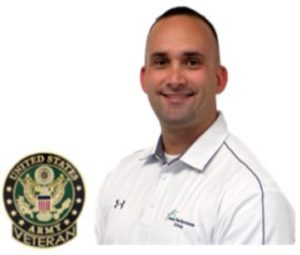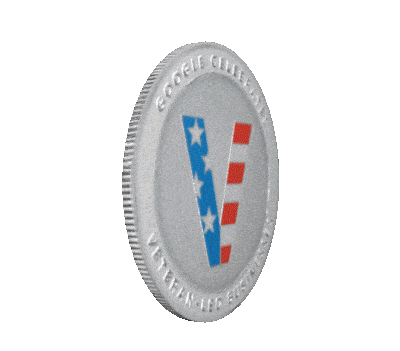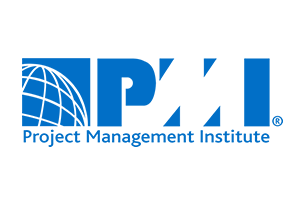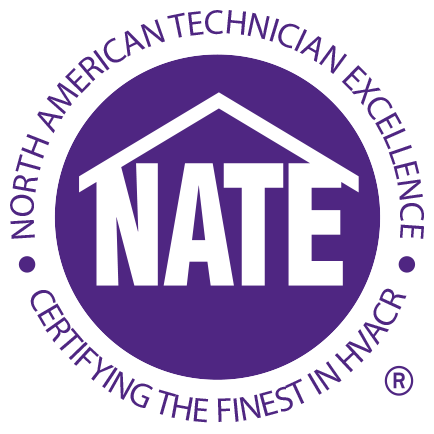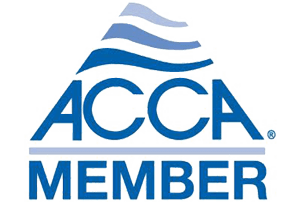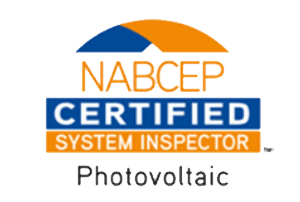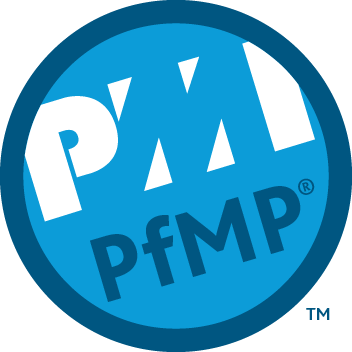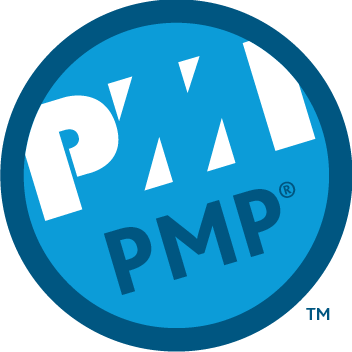Do I Need a Sewer Backwater Valve for My Home?
An in-home sewer backwater valve can reduce your worry and help prevent a sewage backup. The United States Environmental Protection Agency (EPA) studies and assesses sewage back-ups and overflows to determine both impact and prevention. The EPA defines a sewer back-up as an SSO (Sanitary Sewage Overflow). SSOs spill raw sewage from the public sanitary sewer system into homes, streets, waterways, and into drinking water systems through overflows and backups. The EPA estimates there are as many as 75,000 sewage back-ups per year in the United States.
The CERF (Civil Engineering Research Foundation) found the number of sewer back-ups are increasing at an alarming rate, roughly 3 percent per year. A survey of 79 municipal sewer agencies revealed 65 percent of utilities reported sanitary sewer overflows during wet weather events. The utilities stated 15 to 35 percent of their sewers were filled above capacity during heavy rains resulting in back-ups. 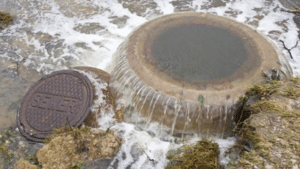
Several factors contribute to the prevalence of sewage backups. The most obvious cause is aging sewer pipes over 30 years old, particularly clay and cast iron pipes, that develop cracks and breaks due to corrosion and degradation. Clay and cast iron pipes were very common sewer lateral material installed in older homes. An additional contributing factor is public sewer systems that allow homes and businesses to combine both sanitary sewage conveyance, with storm water run-off. During heavy rain events, the storm run-off can overwhelm the sewer pipe carrying capacity leading to overflows. Generally, combined systems are only found in older cities due to stringent federal regulation that discourage combination systems. Another factor contributing to SSOs are tree and shrub root infiltration into sewer pipes through failed joints, cracks and other openings. The roots seek out water, finding it readily available in compromised sewer piping. 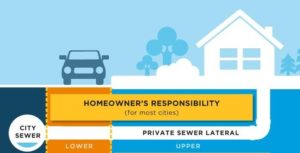
Health Hazards of Sewage Overflow in a Home
According to the EPA, raw sewage can carry multiple human hazards including bacteria, viruses, parasitic organisms, intestinal worms, and inhaled molds and fungi. 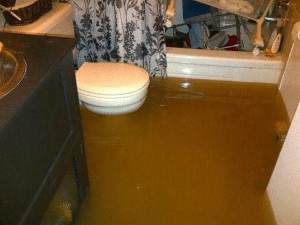
Sewer Backwater Valves Prevent Back-Ups
There are two important requirements in the IPC (International Plumbing Code) that help minimize or reduce the risk of sewage back-ups into homes. First, the treatment and conveyance of storm water. Storm water is defined as rainwater from roofs, paved areas, yards, courts, and courtyards. Most sanitary sewers, particularly those in older cities, were not designed to handle unusually large sudden inflows of storm water during rain events or natural disasters. 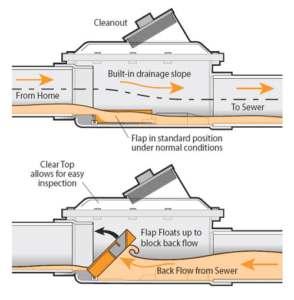
The second requirement is the installation of backwater check valves not only in any storm water or subsoils drains, but in the main building sanitary sewer line. IPC section 714.1 requires the installation of a sewer backwater valve when a plumbing fixture is installed on a floor with a finished elevation below the elevation of the next manhole cover upstream in the public sewer. This ensures in the event of a blockage in the main sewer at the street, raw sewage backs up in the main, the sewer backwater valve closes preventing sewage overflow into the home through floor drains or other plumbing drain fixtures in the basement. To ensure the backwater valve is periodically inspected, serviced or requires replacement, IPC 714.3 goes on to require that backwater check valves are installed so the working parts of the valve are accessible.
A FEMA (Federal Emergency Management Agency) case study found a local community backwater valve 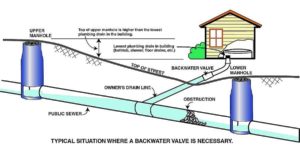
Home Flooding and Homeowners Insurance
Ninety percent of all natural disasters, including heavy rain events, involve some type of flooding. Sanitary sewage overflow into a home can cause tens of thousands of dollars of damage to personal property, walls, floors, electrical, ductwork, and heating and cooling equipment. Generally homeowners insurance policies do not provide coverage for flood damage to a home. Some insurers may offer flood insurance as a rider or addendum to a standard policy but the premium, if available, may be prohibitively expensive. An additional option is the National Flood Insurance Program which makes federally backed insurance available in participating communities. The best option is simply to prevent sanitary sewer overflow and back-ups all together with the installation of a backwater valve in the home’s main sewer lateral. This simple and effective choice can protect your home, personal belonging and health.
Home Performance Group Sewer Line Repairs in Kansas City
The main sewer lateral is a critical component in a home’s plumbing system. A safe and sanitary sewer with a code compliant installation, protected with a backwater valve, is vital to protecting people’s health. According to ASCE (American Society of Civil Engineers) the United States wastewater infrastructure is graded as a “D” with more 600,000 miles of sewer pipes with an average age of 33 years. Meaning a large number of homes may have future sewer overflow and back-up risks. Consider hiring a licensed plumbing professional with expert knowledge to inspect your home’s plumbing system. Investment in a backwater valve may help prevent sanitary sewer overflows into the home saving tens of thousands in flood remediation.
At Home Performance Group, we continue to invest in technical plumbing training so we can safely install and repair sanitary sewer pipes, laterals, and protective backwater valves. We have performed numerous sewer line installations, repairs, and backwater valve upgrades for our clients.
If you are interested in a no-cost in-home consultation, schedule with a Solutions Advisor today.

Article by Larry L. Motley Jr., 25 October 2021
Larry is a graduate of both Wentworth Military Academy and Missouri Western State University earning a double bachelor’s degree in Economics and Finance. Additionally, he maintains six professional tradesman licenses in two states and advanced credentialing in green technology, project and program management, and process improvement. Larry is a three-time combat veteran having served in Operation Iraqi Freedom, Operation New Dawn, and Operation Inherent Resolve. He continues to serve through a value-based building science company focused on providing clients the best design, highest quality installation, and most honest repair services in the community.


Featured Service Areas:
| Missouri | Kansas | ||||
|---|---|---|---|---|---|
|
Belton Blue Springs Cameron Excelsior Springs Gladstone Holt |
Independence Kansas City Kearney Lathrop Lawson Lee's Summit |
Liberty North Kansas City Parkville Platte City Plattsburg Polo |
Raytown Riverside Smithville Sugar Creek Weston |
Kansas City Lansing Leavenworth Leawood Lenexa |
Merriam Mission Mission Hills Praire Village Shawnee |



